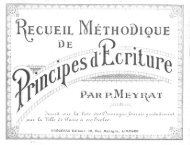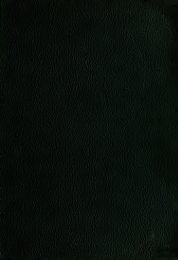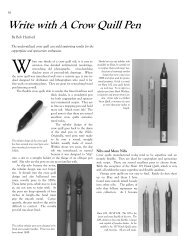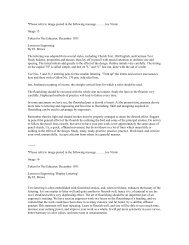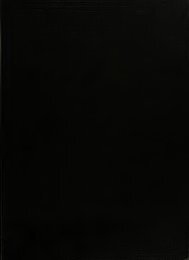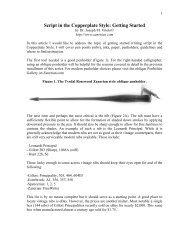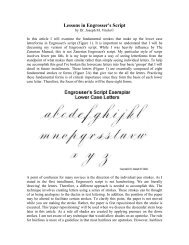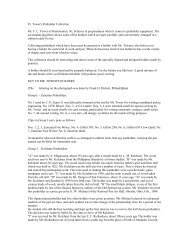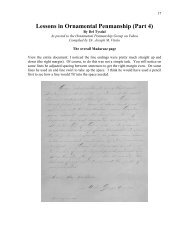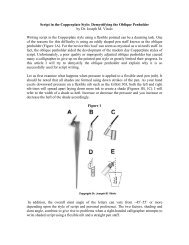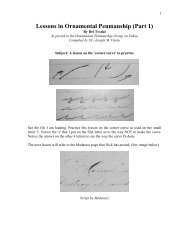The Educator (Volume 45) - IAMPETH
The Educator (Volume 45) - IAMPETH
The Educator (Volume 45) - IAMPETH
Create successful ePaper yourself
Turn your PDF publications into a flip-book with our unique Google optimized e-Paper software.
1. Do you have a philosophy of<br />
education and do you practice<br />
what you preach ? Someone<br />
has said that the school is<br />
simply your philosophy trans-<br />
2.<br />
3.<br />
lated into visible form.<br />
Did you know that research says<br />
that usually left-handed pupils<br />
should be taught to write with<br />
the right hand?<br />
Do you believe that the quality<br />
and style of writing which pupils<br />
4.<br />
see on the blackboards affect<br />
their own writing? What does<br />
your school do about it? What<br />
should we do?<br />
Do you teach exclusive arm<br />
movement, combined movement,<br />
or allow the pupil to do as he<br />
pleases. Which movement is accepted<br />
as satisfactory or uni-<br />
5.<br />
versal ?<br />
How much time is<br />
a pupil to master<br />
required by<br />
pen-and-ink<br />
6.<br />
writing of a quality sufficient to<br />
meet life needs ?<br />
Should we give fountain pens to<br />
pupils of third and fourth<br />
grades? Are pencils unsatisfactory<br />
?<br />
7. Sheuld we change the spacing<br />
of lines on primary paper so<br />
that the writing not only is<br />
smaller, but also so that the<br />
8.<br />
9.<br />
10.<br />
b<br />
f<br />
11.<br />
proportion of loop letters to<br />
small letters remains the same<br />
throughout all grades?<br />
Are quality and speed related?<br />
If so, how ?<br />
Should legibility be our sole<br />
criterior of a pupil's work?<br />
Should all penmanship practice<br />
be diagnostic in nature only?<br />
Or should there be a balance of<br />
positive, constructive, directional<br />
drill?<br />
How much manuscript writing<br />
should be used? Where should<br />
the transition to cursive writing<br />
be made? Will manuscript be<br />
permanently retained as a system?<br />
Can it be mastered as<br />
easily as cursive ?<br />
12. Should there<br />
for writing?<br />
be a daily period<br />
In what grades?<br />
<strong>The</strong> answers to these and other<br />
questions cannot be found at a single<br />
sitting. <strong>The</strong>re must be much reading,<br />
much study and research, much discussion,<br />
practice, and experimentation.<br />
Read as Much as You Can<br />
Last month at one of the national<br />
conventions, a famous educator contended<br />
that teachers as a group read<br />
less than members of any other profession.<br />
Is this true of penmanship<br />
teachers ? Lack of time is the most<br />
common excuse for not reading more<br />
than we do, professionally. Could it<br />
be a lack of interest?<br />
May I refer you to a few of my<br />
favorites, whether you read them or<br />
not?<br />
I<br />
1. What Does Research Say? Bulletin<br />
No. 308, published by Eugene<br />
B. Elliott, Supt. of Public<br />
Instruction, Lansing, Mich.,<br />
1937.<br />
2. <strong>The</strong> Implications of Research for<br />
the Classroom Teacher. N.E.A.,<br />
1201 Sixteenth Street, N.W.,<br />
Washington, D. C, $1.00.<br />
3. A Manual for Left Handed Writing.<br />
Published by Dr. Warren<br />
H. Gardner, Iowa City, Iowa,<br />
1936. (Prepared for psych, and<br />
speech clinics and for penmanship<br />
teachers.)<br />
4. Learning the Three R's by Gertrude<br />
Hildreth, Educational Publishers,<br />
Inc., 1936.<br />
5. Public Secondary School by<br />
Espy, Houghton Mifflin Co.,<br />
1939.<br />
Strengthen thy stakes. Drive them<br />
deeper into the rich, mellow soil of<br />
accumulated experience. Double the<br />
stakes whenever you feel yourself<br />
weakening, or you see a stonn of<br />
doubts arising. Dr. Freeman says,<br />
"<strong>The</strong> absolute importance of handwriting<br />
is as great as it ever was,<br />
and a widespread belief that handwriting<br />
has greatly decreased in importance<br />
is one of the most serious<br />
obstacles to effective teaching."<br />
THE ENGLISH<br />
LANGUAGE<br />
is the most important sci-<br />
entific instrument at your<br />
disposal. Learn to speak<br />
and write it with precision.<br />
C. W. FOULK,<br />
Ohio State University.<br />
Cursive writing is still the prevailing<br />
style taught throughout America,<br />
although more than 20 ^'c of large<br />
cities teach manuscript in the first<br />
two grades.<br />
Ever Changing Program<br />
It is interesting to study the<br />
changes in the elementary school program<br />
during the past two hundi-ed<br />
years. For instance in 1700 one finds<br />
that reading, writing and religion<br />
were the only subjects; in 1750, spelling<br />
and arithmetic had been added;<br />
by 1900, the number of subjects had<br />
grown to fifteen; while in 1931, in<br />
most systems, there were twenty or<br />
more subjects in the elementary<br />
school.<br />
Recently I had the pleasure of reading<br />
two old courses of study. One<br />
had been in use in Honesdale, Pa. in<br />
1873-4. Penmanhip began in the 3rd<br />
grade and continued through the seventh.<br />
<strong>The</strong> Academic Department included<br />
the 8-9-10 grades. <strong>The</strong> following<br />
note is quoted: "Elocution, Penmanship,<br />
and Drawing receive due<br />
attention during the course; and special<br />
classes in studies mentioned<br />
15<br />
above are formed whenever occasion<br />
demands."<br />
<strong>The</strong> textbook adopted for penmanship<br />
was written by Potter and Hammond.<br />
<strong>The</strong> other course of study had<br />
been used in our city in 1879. For<br />
first and second grade penmanship<br />
the course read: "On slates and blackboard.<br />
Make the copy always a sentence.<br />
Avoid printing. Long pencils<br />
should be used and care exercised<br />
that they be properly held." Ink was<br />
introduced in the 3rd grade. Much<br />
tracing was done in copybooks.<br />
Important Means of Expression<br />
Many wonder why we do all this<br />
talking about penmanship. In answering<br />
that question, may I say<br />
that it seems to me that writing is<br />
just as important a means of expression<br />
as talking, and we need much<br />
more training in both of them than<br />
we have had to enable us to do them<br />
easily, gracefully, and pleasurably to<br />
the performer, the listener, or the<br />
reader. <strong>The</strong> three R's have been with<br />
us many years and there's no doubt<br />
about their need in years to come.<br />
Cooperative Attitude<br />
Influences in the schools and outside<br />
the school affect the quality of<br />
handwriting in any school system". To<br />
strengthen the stakes in the school,<br />
we must begin with the attitude of<br />
all teachers of all subjects toward<br />
handwriting. Standards of attainment,<br />
the objectives, the demands<br />
must be consistent on the part of all<br />
teachers. Integration, correlation,<br />
fusion of efforts may be the solution.<br />
Every teacher should be a teacher of<br />
writing and spelling.<br />
From the Known to the Unknown<br />
Fundamentally, the approach to all<br />
subjects is the same. <strong>The</strong>re should<br />
be a two-way reach—backward to<br />
what we are sure of and forward to<br />
the unknown. This means of course<br />
that the teacher is an artist not an<br />
artisan; a creative teacher — not a<br />
subject minded dictator of the classroom.<br />
<strong>The</strong> creative teacher goes no<br />
faster than she can take her pupils<br />
with her. She cannot reach all pupils<br />
alike. She does not force. Results<br />
may be delayed, but never denied<br />
when the creative teacher is the guide.<br />
It is not the equipment nor the materials<br />
that helps a pupil to do. Mastery<br />
of skills is not enough. It's the<br />
creative teacher who can put a song<br />
in her pupil's heart, who can make<br />
him want to do, who appreciates the<br />
good she sees, who does not kill the<br />
spirit in attempting to perfect form<br />
and who throws out torches not fire<br />
extinguishers. Do you want to be an<br />
artist or an ai-tisan ?<br />
Emerson says: "Be careful what<br />
you want; you'll get it."<br />
Respect and Confidence<br />
True democracy in education demands<br />
the mutual respect of teachers<br />
and pupils. It is a person to person<br />
relationship. A pupil and his teacher<br />
must have confidence in each other<br />
(Continued on Page 23)



